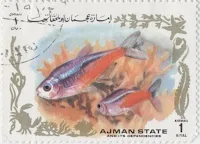country: Azerbaycan (Azerbaijan Turkey)
topic: Külme Rutilus Rutilus Caspicus
theme: Fish, Animals
type of stamp: postal stamp (Azerbaycan Poçtu)
color: multi-coloured
year: 1993
postal value: 1,50 m.
Information:
The Rutilus caspicus (better known as the Vobla (Wobla), a Russian word for the Caspian Roach). This fish is very popular in Russian restaurants and households. A salt-dried vobla is a common Russian meal or Snack by a glass of beer.
The Vobla has a size of 30-35 cm (max. 45 cm) and has a weight of around the 800 g. The natural habitat is in the coastal waters of the northern and northwestern Caspian Sea and also enters Volga, Ural, Emba, Terek and Kura. (source: Wikipedia / go to: Rutilus caspicuson on Wikipedia )
Free Online Stamp Catalogue with Wiki information about almost every stamp. This is more than just a Free Online Stamp Catalogue. (FR) Catalogue Online Gratuit de Timbre. (NL) Gratis Online Postzegel Catalogus.
Showing posts with label animals. Show all posts
Showing posts with label animals. Show all posts
Fish (animals) stamp, Ajman State (United Arab Emirates), 50 Dirhams, multicoloured
country: Ajam State (United Arab Emirates)
topic: fish
theme: animals
type of stamp: postal stamp
color: multicoloured
postal value: 50 Dirhams
More from the same series:
Fish 50 Dirhams
Fish 1 Riyal
topic: fish
theme: animals
type of stamp: postal stamp
color: multicoloured
postal value: 50 Dirhams
More from the same series:
Fish 50 Dirhams
Fish 1 Riyal
Labels:
50 Dirhams,
Ajman State,
animals,
fish,
Middle East,
multicoloured,
postal stamp,
United Arab Emirates
Fish (animals) stamp, Ajman State (United Arab Emirates), 1 Riyal, multicoloured
country: Ajam State (United Arab Emirates)
topic: fish
theme: animals
type of stamp: postal stamp
color: multicoloured
postal value: 1 Riyal
More from the same series:
Fish 50 Dirhams
Fish 1 Riyal
topic: fish
theme: animals
type of stamp: postal stamp
color: multicoloured
postal value: 1 Riyal
More from the same series:
Fish 50 Dirhams
Fish 1 Riyal
Labels:
1 Riyal,
Ajman State,
animals,
fish,
Middle East,
multicoloured,
postal stamp,
United Arab Emirates
Lion horse (big cats), Belgium Congo, stamp, 2,5 F, 1943, carmine red
country: Belgium Congo (Belgisch Congo - Congo Belgique)
code: BL6 (241)
topic lion horse
theme: animals, mammals, big cats, predators
type of stamp: postal stamp
color: carmine red
year: 1943
publication date: 01/12/1943
postal value: 2,5 F
comments:
See also 1942 for the stamps without booklet.
These boxes come from the Messages blocks, they were cut off and provided with an imprint. 300 blocks by and under the control of the 'Committee of Culture' overprints with 'tribute' Universal Postal Union, and this on the occasion of its 75th anniversary.
code: BL6 (241)
topic lion horse
theme: animals, mammals, big cats, predators
type of stamp: postal stamp
color: carmine red
year: 1943
publication date: 01/12/1943
postal value: 2,5 F
comments:
See also 1942 for the stamps without booklet.
These boxes come from the Messages blocks, they were cut off and provided with an imprint. 300 blocks by and under the control of the 'Committee of Culture' overprints with 'tribute' Universal Postal Union, and this on the occasion of its 75th anniversary.
Labels:
1943,
2.5 F,
animals,
Belgisch Congo,
Belgium Congo,
big cats,
Congo du Belgique,
lion horse,
mammals,
postal stamp,
predators
African Elephant stamp Belgium Congo (Belgisch Congo / Congo Belgique), red, 1 Fr., 1931

country: Belgium Congo (Belgisch Congo / Congo Belgique)
code: 176
topic: African Elephant
theme: animals / mammals
type of stamp: postal stamp
number of stamps per sheet: 75
circulation: 28600
kind of serration: 11,5
color: red
paper type: tinted paper
engraving (engraving): Graphics Institute of Paris
engraving type: intaglio
cylinder shape (book press): Seal factory (Mechelen)
year: 1931
publication date: 01/04/1931
postal value: 1 Fr.
comments:
1st day of disposal: 01/09/1942
See also 1937 postage stamp booklet
Information:
The African elephants are the species of elephants in the genus Loxodonta (Greek for 'oblique-sided tooth'), one of the two existing genera in Elephantidae. Although it is commonly believed that the genus was named by Georges Cuvier in 1825, Cuvier spelled it Loxodonte. African elephants are bigger than Asian elephants.
Elephants have four molars, each weighs about 5 kg (11 lb) and measures about 30 cm (12 in) long. As the front pair wears down and drops out in pieces, the back pair shifts forward, and two new molars emerge in the back of the mouth. Elephants replace their teeth six times. At about 40 to 60 years of age, the elephant no longer has teeth and will likely die of starvation, a common cause of death.
Their tusks are teeth, the second set of incisors become the tusks. They are used for digging for roots and stripping the bark off trees for food, for fighting each other during mating season, and for defending themselves against predators. The tusks weigh from 23–45 kg (51–99 lb) and can be from 1,5–2,4 m (5–8 ft) long. Unlike Asian elephants, both male and female African elephants have tusks. The enamel plates of the molars are fewer in number than in Asian elephants.
Males stand 3,2–4,0 m (10–13 ft) tall at the shoulder and weigh 4,700–6,048 kg (10,000–13,330 lb).
Females stand 2,2–2,6 m (7,2–8,5 ft) tall and weigh 2,160–3,232 kg (4,800–7,130 lb).
There are 2 species of African elephants left: the African bush elephant (Loxodonta Africana) and the African forest elephant (Loxodonta Cyclotis).
(source: Wikipedia, read more about the African Elephant on Wikipedia)
More info about the elefant.
Meer info over de elefant.
Subscribe to:
Posts (Atom)



